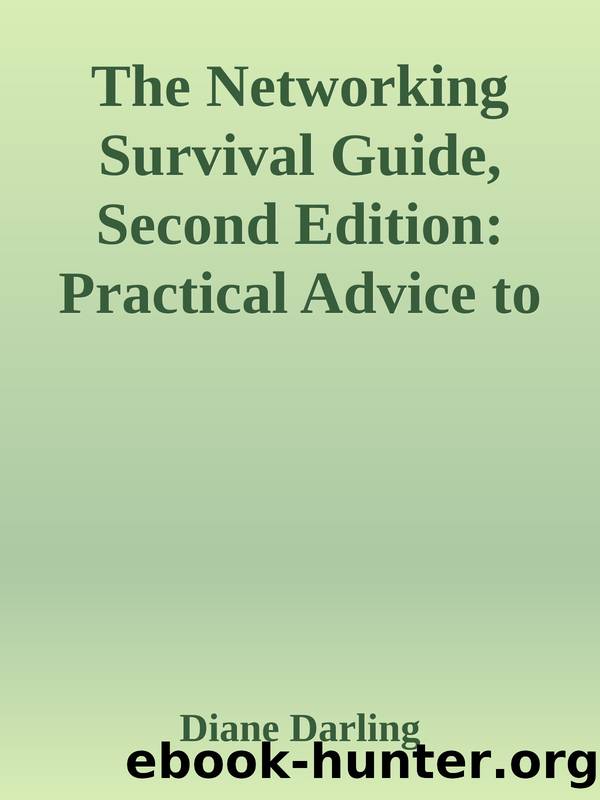The Networking Survival Guide, Second Edition: Practical Advice to Help You Gain Confidence, Approach People, and Get the Success You Want by Diane Darling

Author:Diane Darling
Language: eng
Format: epub
Tags: 0071717587, 9780071717588
ISBN: 0071717587
Published: 2010-06-26T07:00:07+00:00
3. Why the other person should care
138
THE NETWORKING SURVIVAL GUIDE
Use words such as help, provide, contribute, give, serve, teach, and solve. The introduction is about what you can do for others, not what they can do for you. Your introduction is successful if it invites questions. If it shuts down the conversation, it was unsuccessful, and you need to rework it.
Here are some examples:
⢠âIâm an exhibitor at this show from People Technology, my name is Susan Smith, and we help companies fi nd the right people for their technology positions.â
⢠âIâm a speaker at the conference, my name is George Adams, and I help companies identify and execute their marketing strategy.â
Here is an example at a meeting:
⢠âIâm in the fi nance department, my name is John Dunn, and Iâm here to help with the business plan.â
This is awkward when you fi rst try it. Just practice and it will become easier. I encourage you to say the phrase âmy name isâ
because this phrase will slow you down and indicate to the listener: Iâm going to hear a name.
You may want to add something humorous. During one of the training sessions for relationship managers at a bank, a gentleman said that he âmanaged relationships but couldnât help out with the one at home.â It got a good laugh and was very memorable.
When men fi rst meet, they immediately introduce themselves.
Women sometimes do, but not as frequently.
Summary: In business, you should simply say who you are and what is your connection to the meeting, event, or whatever you may be attending. As much as possible, provide information that will spark a dialogue.
BEST PRACTICES
139
One Size Doesnât Fit All
You need to master a variety of introductionsâafter all, you have multiple roles. If you are at your childâs baseball game, introducing yourself with your title from work would come across as odd, to say the least, as would the oppositeâfor example, if you were at a conference and you introduced yourself as Jimmyâs dad.
Introduce Someone Else
When you are meeting business professionals, you are often called upon to introduce other people. This can be a formal introduction or something more casual. Use this opportunity as an excellent way to get conversations started. If the introductions are in a more formal setting, here are some guidelines to follow for the proper order:
⢠Younger to older
⢠Junior to senior
⢠Company employee to guest company individual
⢠Your executive to customer or client
Other pointers:
⢠Start with the personâs name.
⢠Then give her title or role.
⢠Give the name of the company (if necessary).
⢠Mention something that is unique about the person.
Hereâs a sample introduction: âSusan Jones, I would like you to meet Jack Collins, our vice president of marketing. Jack, this is Susan, our new manager of customer service. Jack is an avid sailor.
Susan sails at the MIT Yacht Club.â
140
THE NETWORKING SURVIVAL GUIDE
Names
Using someoneâs name is important when making introductions. Here are some guidelines.
⢠Learn what name the person actually uses. For example, is it Richard or Rick, Deborah or Deb?
⢠Use a nickname only if that is what the person uses in business.
Download
This site does not store any files on its server. We only index and link to content provided by other sites. Please contact the content providers to delete copyright contents if any and email us, we'll remove relevant links or contents immediately.
| Business School Guides | GMAT |
| Guides | Interviewing |
| Job Hunting | Job Markets & Advice |
| Resumes | Vocational Guidance |
| Volunteer Work |
The Motivation Myth by Jeff Haden(5156)
Audition by Ryu Murakami(4850)
Adulting by Kelly Williams Brown(4487)
The Confidence Code by Katty Kay(4187)
A Mind For Numbers: How to Excel at Math and Science (Even If You Flunked Algebra) by Barbara Oakley(3220)
Waiting in the Wings by Melissa Brayden(3178)
Self-Esteem by Matthew McKay & Patrick Fanning(3092)
Fooled by Randomness: The Hidden Role of Chance in Life and in the Markets by Nassim Nicholas Taleb(3044)
The ONE Thing by Gary Keller(3009)
Nice Girls Don't Get the Corner Office by Lois P. Frankel(2995)
The Dictionary of Body Language by Joe Navarro(2947)
How to be More Interesting by Edward De Bono(2746)
Designing Your Life by Bill Burnett(2667)
Getting Things Done by David Allen(2646)
The Plant Paradox by Dr. Steven R. Gundry M.D(2547)
Police Exams Prep 2018-2019 by Kaplan Test Prep(2487)
What Color Is Your Parachute? 2015 by Richard N. Bolles(2262)
Dangerous Personalities by Joe Navarro(2232)
When to Jump by Mike Lewis(2204)
